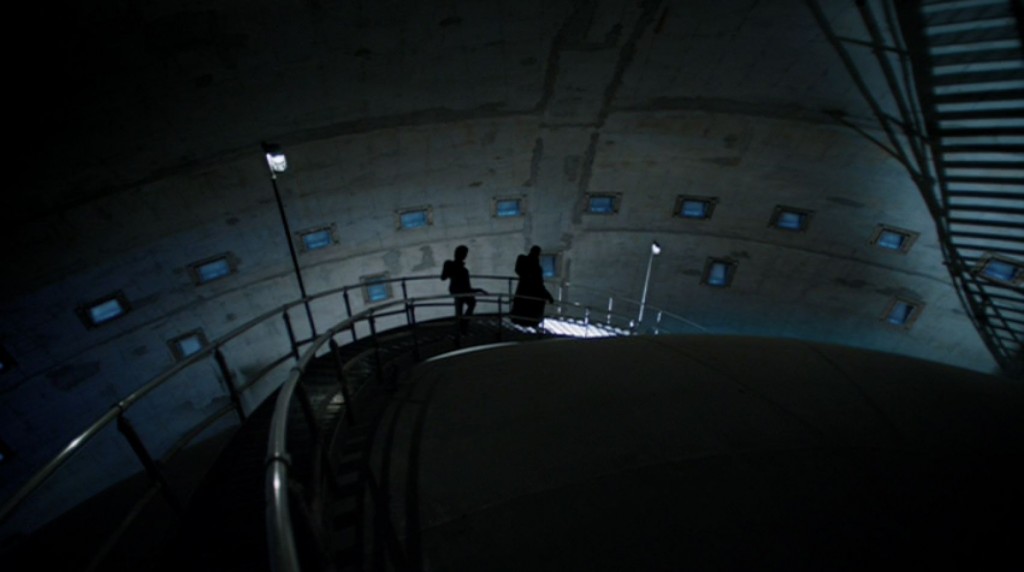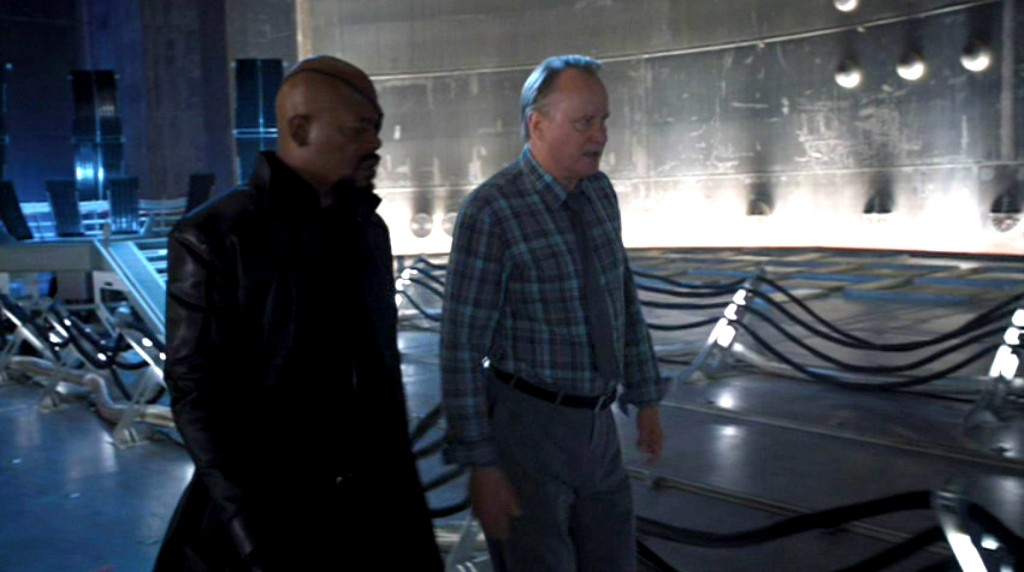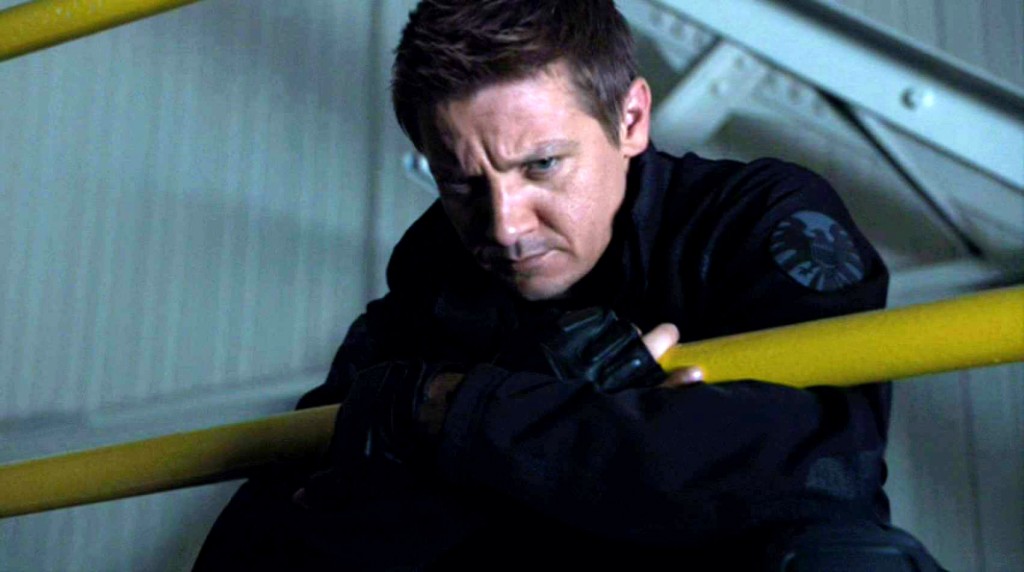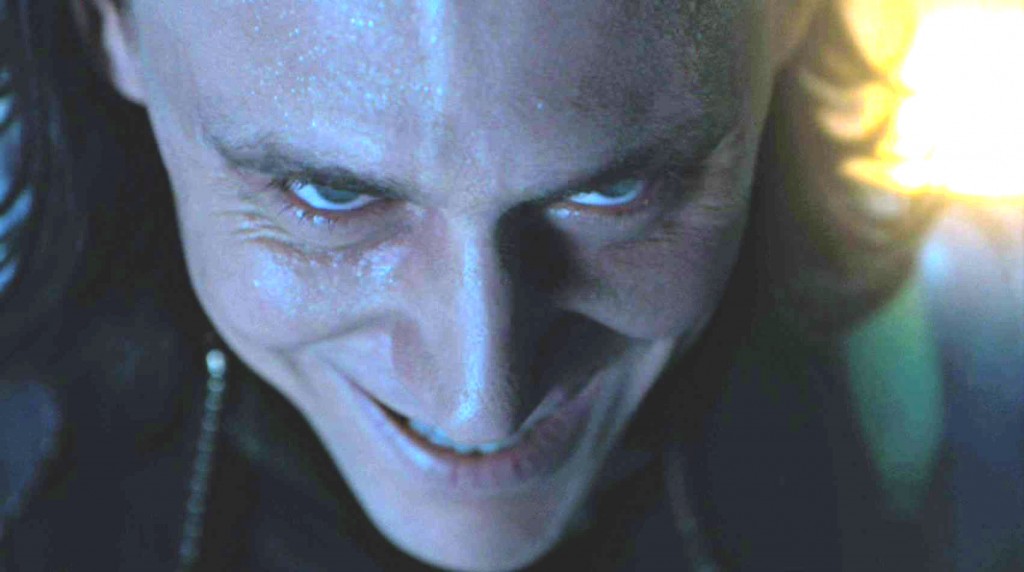The Avengers part 3
Our protagonist, Nick Fury, gets out of his helicopter, along with his sidekick Agent Maria Hill, and exchanges some rapid-fire dialogue with Agent Coulson as he heads down, down, down into the depths of the installation. He’s arrived in a helicopter, a symbol of power, and now he descends deep, deep underground. What does he talk about with Coulson? “A bunch of stuff.” The Tesseract, we come to understand, has done something surprising, which has necessitated the evacuation of the installation. The Tesseract, which, again, we don’t know what it is or what it does, is kept deep, deep underground because it’s so freaking powerful.
(Incidentally, why must the installation be evacuated? The answer: because The Avengers, in order to make the ton of money it needs to make, must be rated PG-13. The installation is about to go sky-high, so to speak, and if the movie begins with a catastrophic loss of life, it becomes Saving Private Ryan instead of the colorful spectacle it needs to be.)
Nick Fury gets to the Tesseract Lab and meets up with Dr. Selvig, who seems to be in charge of Things Tesseract. We are told for the third or fourth time in a minute that the Tesseract is doing something weird. This is a useful script note: since so much information is getting thrown at the audience all the time, keep reminding the viewer, in different ways, what the headlines are and why things are important.
What exactly goes on in the Tesseract Lab when the Tesseract is not being weird? I guess Dr. Selvig and company do research on it, and try to figure out how to harness it as an energy source. I say “I guess” because I can’t figure out from the design of the lab what’s supposed to happen there. There’s the Tesseract, held in some kind of Big Round Thing that looks like it was borrowed from Tony Stark’s lab, and then there are a bunch of cables leading to some kind of staging area, and there are scientists who examine the Tesseract by poking at it with a stick. No, really. Obviously, Tesseract Studies are a very new thing, if the level of examination is at the “poking at it with a stick” phase.
Dr. Selvig grunts some lines about the nature of the Tesseract. It’s from outer space, it’s being weird, no one knows what to do, outside of poking at it with a stick.
Nick Fury has barely spoken to Dr. Selvig about the possible imminent destruction of the planet before he asks about another character, Agent Barton, or Hawkeye. The Avengers is supremely busy, with five important characters, all of whom will have competing and intertwining agendas, all being introduced in the first four minutes. Nick Fury chats with Hawkeye, who informs him that the Tesseract is “a doorway to the other end of space.” Why does Hawkeye tell Fury this, and not Dr. Selvig? For that matter, why does Fury need to talk to Hawkeye? For that matter, why is Hawkeye even there?
Fury talks to Hawkeye so that we will understand that Hawkeye is a proficient, if detached, agent of SHIELD, so that when SOMETHING BAD happens to him in a moment, we will have a vague understanding of who he is and what has been damaged.
Right on time, that something bad happens. The Tesseract goes kerblooey and blasts out a beam of energy at the staging area at the other end of the lab (still not sure what that thing’s doing there) and, in a flourish of smoke and a pose in homage to Hannibal Lecter, our antagonist appears, Loki. This is, of course, the “ally” The Other spoke of, and here he is, with his special alien sceptre. I was about to identify Loki as our primary antagonist, but The Avengers does an unusual thing with its antagonists; it staggers them throughout the narrative, tag-teams them almost, so that their seven-hero narrative has plenty to do.
(We are led to understand that the Tesseract has opened from The Other’s end of space. Are we told how The Other manages to do that, exactly? And if he could have done it at any time, is there some reason why he’s only doing it now? “The Tesseract has awakened,” do they mention at some point how or why that happened? Did I miss something?)
In short order, we learn that Loki’s spear can shoot energy bolts, suck human souls out of their bodies, and also hit things and spear things. Loki trashes the Tesseract Lab (not that it was a model of regimented order to begin with) and tussles with Hawkeye, sucking out his soul and, apparently, turning to his side.
Nick Fury swipes the Tesseract (apparently no one thought to keep it in a safe place, because otherwise how would you poke at it with a stick?) while Loki steals Dr. Selvig’s soul and monologues about his intent: he is here to enslave humanity. Hawkeye, now evil, shoots Fury and Loki, Hawkeye and Selvig hot-foot it out of there.
Turning Hawkeye evil in the first sequence of the movie is The Avengers‘ first stroke of genius. In a narrative with seven superheroes, get one out of the way as soon as possible, but in a dramatically important way. Now you only have six superheroes to deal with.
Nick Fury responds to being shot the way anyone would — he yanks the bullet out of his chest like it’s a piece of gum stuck to his shirt and gets on with things. The beauty of The Avengers is in the way it perfectly captures the comic-book experience: it is both very serious and very silly at the same time, even in the same breath. Its entire cast understands this about the script: it must be played with utter sincerity, especially when it’s at its most ridiculous.
Big chase scene, as Loki and his team try to get out of the installation before it collapses. (Why is it collapsing? No particular reason is given. The blue energy whatsit of the Tesseract causes a collapse of some kind, somehow, for some reason. It’s from outer space, it doesn’t need physics.) Hawkeye and Maria Hill get great action moments, and we begin to understand another of the great narrative ideas of the movie: it’s fun to see superheroes fight supervillains, but it’s even more fun to see superheroes fight each other.
So, the installation collapses, mostly bloodlessly, and Loki escapes with the Tesseract. (It seems kind of odd that a Norse God has to escape in an SUV, but them’s the breaks.) Our protagonist is at war with a Norse God working for an alien force (kind of odd that a Norse God has to work for anyone, much less some aliens) and he needs every weapon in his arsenal.




I think “the Tesseract has awakened” has to do with the humans tampering with it. And to continue Hawkeye’s analogy, doors could also be locked on both sides, and the humans have unlocked their side.
Red Skull & Co. had been able to tap into the power of the Tesseract with relative ease compared to SHIELD. Perhaps that’s because he had a very specific agenda: power a weapon.
It’s possible SHIELD wasn’t getting results because they had too many cooks in the kitchen. And their stick poking is what got the cosmic attention.
As for Hawkeye turning, two things: I would’ve liked if Dr. Selvig said “Hawkeye?” instead of “The Hawk.” It’s a nitpick, but he’s calling the guy by a nickname in either case, so why not use the one that’s actually his superhero name? And the other, I would’ve liked to have seen Barton do a little more heroics in that scene before becoming a Loki stooge. Yeah, it would’ve made the movie longer by a minute, but I still feel he got caught too easily.
And Loki, with the Tesseract, could basically use it to return to Asgard at any time, it would seem (come the end of the film.) Why doesn’t he? There’s a strong argument to be made that really that’s his personal goal out of all of this: to get home. But he did make a deal with Thanos, and if he didn’t make a good effort and just said “I got your magic cube and glow stick, see ya!” then Thanos would be coming after him. This way, whether Loki succeeds or fails in conquering Earth, he still wins.
Oh, and him riding the SUV: Loki’s not all powerful, and while he could get himself out of that situation quite easily, he also needs Selvig. And having Hawkeye and any other SHIELD personal is probably how he gets his intel on The Avengers Initiative, the flying aircraft carrier, and so on. So, he needs to make sure they get away safely from the installation as well.
Eliminating Hawkeye at that stage not only cuts down on the slew of heroes, it gives one of those heroes a reason to care about the situation. Black Widow would have been involved anyway, because it’s her job — but it’s so much more compelling when she has a better reason than “It’s my job.”
Obviously you haven’t gotten that far yet, so my apologies if I’m jumping the gun. But one of the things that fascinates me about the structure of this movie is that the dense packing of main characters means that now more than ever, any given element has to pull double or triple narrative duty if at all possible. In that vein, turning Hawkeye and Selvig cuts down on the good-guy side, gives some of the good guys a personal reason to care, allows Loki to move forward with his plans, puts the good guys at a starting disadvantage so they have something to try and overcome, and provides justification for why Loki’s later attack is so effective: he’s been fed information about SHIELD. All for the price of a couple of brainwashings.
Not to mention (again, jumping the gun–maybe after Todd finishes his piece-by-piece analysis, we can do one big holistic analysis) that turning Selvig gives Selvig a reason to be at the final fight without having to go through one of those arguments like:
Cap: We can’t take him with us, he’s just a scientist.
Selvig: But I’m the only one who knows how to turn off the gate.
Audience: Blerg.
I did not like any of the action in this movie. The heroes almost never do anything clever to get out of a sticky situation. They always win by being strong, or fast or better at fighting.
Like when Thor is in that cage that is plummeting towards the ground. How does he get out? By being strong and having a magic hammer. How does he survive the fall? By being indestructible.
But Thor IS strong and DOES have a magic hammer. I’m pretty sure if I was that strong, and had a magic hammer that was as cool as his, it would be my first line of attack/defense/problem solving, too. Should he have tried to THINK his way out when he found himself suddenly plummeting from the sky in a rapid, downward direction?
I think what Thorsby is getting at is the problem a lot of superhero-team-up narratives have: why is anything a problem when, between the members of your team, you can pretty much solve any problem in the world, including immortality, time-travel, infinite energy, etc?
They should put him in a situation where he had to think to survive. Or have a weaker character that had to think to survive.
While Banner never ends up in that cage, it would’ve been interesting to have a cage that only Banner could get out of. Meaning, while he’s the Hulk, he’s trapped. But once he calms down and returns to being Banner, he can think his way out of it with relative ease.
It would certainly establish more trust between SHIELD and Banner. They in no way want to trap him, and in fact want to put the responsibility on him to be the one to put Hulk in the cage.
I’m sure something like that has to have been thought up for the comics at some point in time.
I thought he DID think his way out. He couldn’t break the glass, but at the last moment he attempted to fly using his hammer in the opposite direction of the ground to decrease the energy of the impact. That was at least my take when I saw the movie.
Mythbusters needs to get on this.